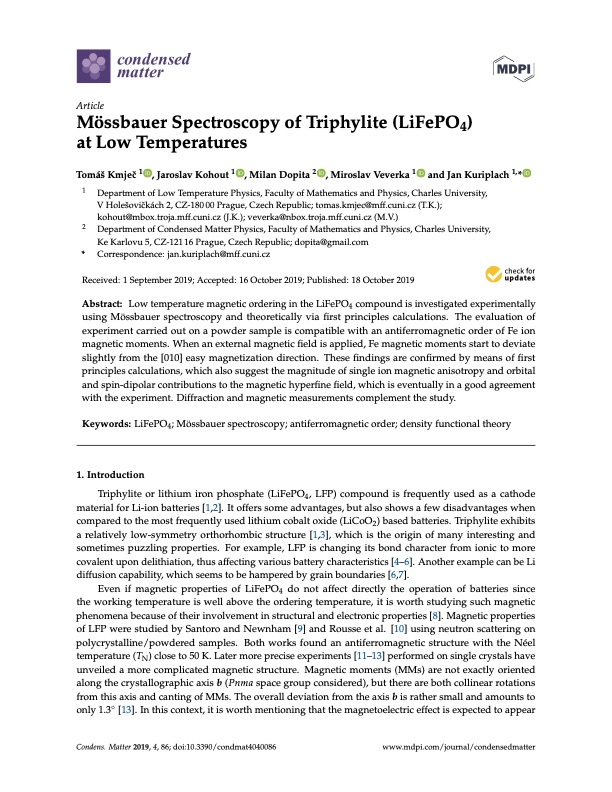
PDF Publication Title:
Text from PDF Page: 001
Article Mössbauer Spectroscopy of Triphylite (LiFePO4) at Low Temperatures Tomáš Kmjecˇ 1 , Jaroslav Kohout 1 , Milan Dopita 2 , Miroslav Veverka 1 and Jan Kuriplach 1,* 1 Department of Low Temperature Physics, Faculty of Mathematics and Physics, Charles University, V Holešovicˇkách 2, CZ-180 00 Prague, Czech Republic; tomas.kmjec@mff.cuni.cz (T.K.); kohout@mbox.troja.mff.cuni.cz (J.K.); veverka@nbox.troja.mff.cuni.cz (M.V.) Department of Condensed Matter Physics, Faculty of Mathematics and Physics, Charles University, Ke Karlovu 5, CZ-121 16 Prague, Czech Republic; dopita@gmail.com 2 * Correspondence: jan.kuriplach@mff.cuni.cz Received: 1 September 2019; Accepted: 16 October 2019; Published: 18 October 2019 Abstract: Low temperature magnetic ordering in the LiFePO4 compound is investigated experimentally using Mössbauer spectroscopy and theoretically via first principles calculations. The evaluation of experiment carried out on a powder sample is compatible with an antiferromagnetic order of Fe ion magnetic moments. When an external magnetic field is applied, Fe magnetic moments start to deviate slightly from the [010] easy magnetization direction. These findings are confirmed by means of first principles calculations, which also suggest the magnitude of single ion magnetic anisotropy and orbital and spin-dipolar contributions to the magnetic hyperfine field, which is eventually in a good agreement with the experiment. Diffraction and magnetic measurements complement the study. Keywords: LiFePO4; Mössbauer spectroscopy; antiferromagnetic order; density functional theory 1. Introduction Triphylite or lithium iron phosphate (LiFePO4, LFP) compound is frequently used as a cathode material for Li-ion batteries [1,2]. It offers some advantages, but also shows a few disadvantages when compared to the most frequently used lithium cobalt oxide (LiCoO2) based batteries. Triphylite exhibits a relatively low-symmetry orthorhombic structure [1,3], which is the origin of many interesting and sometimes puzzling properties. For example, LFP is changing its bond character from ionic to more covalent upon delithiation, thus affecting various battery characteristics [4–6]. Another example can be Li diffusion capability, which seems to be hampered by grain boundaries [6,7]. Even if magnetic properties of LiFePO4 do not affect directly the operation of batteries since the working temperature is well above the ordering temperature, it is worth studying such magnetic phenomena because of their involvement in structural and electronic properties [8]. Magnetic properties of LFP were studied by Santoro and Newnham [9] and Rousse et al. [10] using neutron scattering on polycrystalline/powdered samples. Both works found an antiferromagnetic structure with the Néel temperature (TN) close to 50 K. Later more precise experiments [11–13] performed on single crystals have unveiled a more complicated magnetic structure. Magnetic moments (MMs) are not exactly oriented along the crystallographic axis b (Pnma space group considered), but there are both collinear rotations from this axis and canting of MMs. The overall deviation from the axis b is rather small and amounts to only 1.3◦ [13]. In this context, it is worth mentioning that the magnetoelectric effect is expected to appear Condens. Matter 2019, 4, 86; doi:10.3390/condmat4040086 www.mdpi.com/journal/condensedmatterPDF Image | Mossbauer Spectroscopy of Triphylite (LiFePO4) at Low Temperatures

PDF Search Title:
Mossbauer Spectroscopy of Triphylite (LiFePO4) at Low TemperaturesOriginal File Name Searched:
condensedmatter-04-00086.pdfDIY PDF Search: Google It | Yahoo | Bing
Sulfur Deposition on Carbon Nanofibers using Supercritical CO2 Sulfur Deposition on Carbon Nanofibers using Supercritical CO2. Gamma sulfur also known as mother of pearl sulfur and nacreous sulfur... More Info
CO2 Organic Rankine Cycle Experimenter Platform The supercritical CO2 phase change system is both a heat pump and organic rankine cycle which can be used for those purposes and as a supercritical extractor for advanced subcritical and supercritical extraction technology. Uses include producing nanoparticles, precious metal CO2 extraction, lithium battery recycling, and other applications... More Info
| CONTACT TEL: 608-238-6001 Email: greg@infinityturbine.com | RSS | AMP |